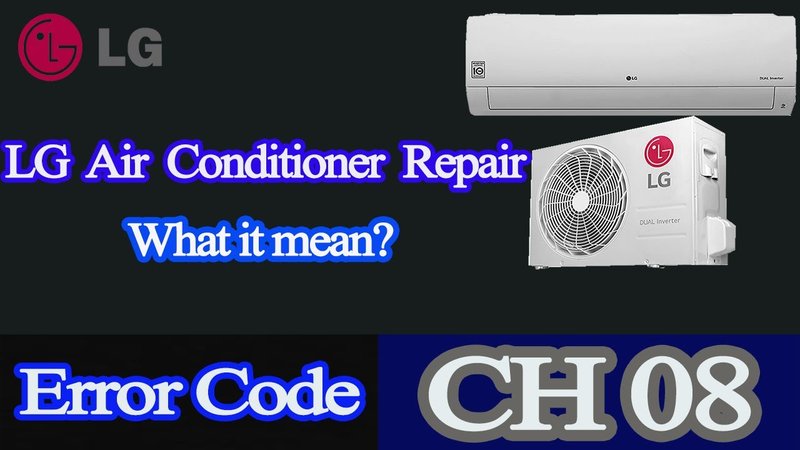
In simple terms, the SE error code on your LG air conditioner indicates a sensor error. Think of the sensor as your air conditioner’s “thermometer.” Just like how you’d feel off if your body thermometer went haywire, your air conditioner feels the same when its sensor acts up. It’s like trying to bake a cake in an oven where the temperature control is misreading the heat. The outcome? Not great. So, it’s crucial to address the SE error to ensure your air conditioner runs smoothly and efficiently.
Understanding the SE Error Code
The SE error code can seem like a cryptic message to many. But breaking it down is pretty straightforward. The “S” in SE stands for “sensor,” while the “E” means “error.” Essentially, your air conditioning unit is letting you know there’s a problem with the temperature sensor or its connection. The sensor is responsible for detecting the room temperature and signaling the unit to adjust its operations accordingly. If your air conditioner’s “brain” isn’t getting accurate information about the room’s temperature, it can’t regulate the cooling effectively.
Imagine you’re driving a car with a faulty speedometer. You wouldn’t know when to slow down or speed up, leading to potential inefficiencies or even hazards—it’s the same with your air conditioner. If the sensor isn’t relaying the correct information, your unit could be overworking or underperforming, affecting both your comfort and electricity bill. Addressing the SE error prevents these inefficiencies, saving you from higher costs and uncomfortable temperature fluctuations.
Now, you might think, “Can’t I just reset the air conditioner?” While resetting might clear the code temporarily, it’s a bit like putting a band-aid on a cut that needs stitches. The underlying issue remains unresolved, and the error’s likely to return. So, what’s the next step if you encounter this error? A good start is to consult the user manual or reach out to LG’s customer support for guidance. They can provide insights specific to your model and situation.
Common Causes of the SE Error Code
Understanding why the SE error code appears is half the battle. The culprit is often a loose connection or fault within the sensor system. Over time, wires may loosen due to vibrations or natural wear and tear. Just like you periodically check your car’s oil and tire pressure, maintaining the connections in your air conditioner is crucial for its longevity and performance.
In some cases, the sensor might be dirty or damaged. Think of it like trying to see through a smudged window—the information getting through is distorted. Dust and grime can build up on the sensor, causing it to misread the room temperature. Regular cleaning ensures that your sensor can “see” clearly, relaying accurate data to the air conditioner’s control system.
Another potential cause is a malfunctioning control board. This might sound technical, but in simple terms, the control board is like the air conditioner’s “brain.” If it isn’t processing the sensor’s information correctly, you could see the SE error code. While this might require professional intervention, it’s crucial to resolve such issues promptly to prevent them from escalating into bigger problems.
Steps to Address the SE Error Code
So, you’ve got the SE error code. What now? First, ensure the unit is off before doing any inspection—you don’t want any unexpected surprises! Begin by checking the sensor’s connections. Like reconnecting a loose headphone jack, securing any loose wires might just solve the problem. This simple fix often resolves the error, saving you time and money.
If the error persists after checking the connections, cleaning the sensor with care is a logical next step. Use a soft, dry cloth to gently wipe away any dust or debris. This step can work wonders, especially if the sensor hasn’t been cleaned in a while. However, be gentle to avoid causing any damage.
If these steps don’t resolve the issue, it’s wise to call a professional. They can perform a thorough check-up, ensuring all components function correctly. It’s much like going to a mechanic for a comprehensive car inspection. Although you might be hesitant to incur the cost, remember that preventative maintenance often saves money in the long run, sparing you from more significant repairs down the road.
Why You Shouldn’t Ignore It
Ignoring the SE error code can lead to a cascade of problems. Imagine leaving a small leak unattended in your roof—it doesn’t seem like a big deal until a storm hits. Similarly, ignoring the SE error can lead to inefficient cooling, higher energy bills, and even mechanical failures. Your air conditioner has to work harder to compensate for the faulty readings, leading to wear and tear on the unit.
Moreover, an air conditioning unit that’s running inefficiently might not cool your home effectively. This could mean you’re sweating it out during the peak of summer heat, not to mention the frustration of dealing with a malfunctioning appliance. Addressing the SE error promptly ensures you stay cool and comfortable without the stress and fuss.
Lastly, resolving the SE error can extend the life of your air conditioner. Regular maintenance and prompt repairs are like health check-ups for your unit. They ensure everything runs smoothly, preventing small issues from ballooning into major problems. So, while it might seem like a minor inconvenience to deal with the error, in the bigger picture, it contributes to the longevity and efficiency of your cooling system.
In conclusion, don’t ignore the LG air conditioner’s SE error code. By addressing it promptly and effectively, you can maintain comfort, save money, and prolong the life of your appliance. After all, peace of mind comes with knowing your home will stay cool and refreshing all summer long.